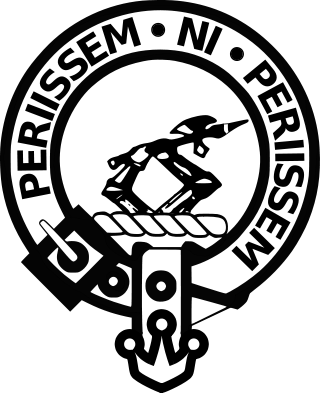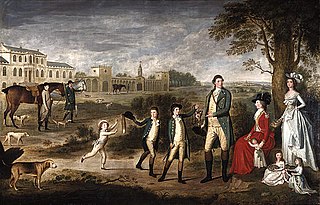Early life

Anstruther was baptized on 24 September 1658, the third son of Sir Philip Anstruther of Anstruther, Fife, a member of the Scottish Parliament, and his wife Christian Lumsden, daughter of Sir James Lumsden of Innergellie, Fife. [1]
Sir Robert Anstruther, 1st Baronet (1658 – March 1737), of Wrae, Linlithgow, and Balcaskie, Fife, was a Scottish politician who sat in the Parliament of Scotland between 1681 and 1707 and in the British House of Commons from 1709 to 1710.

Anstruther was baptized on 24 September 1658, the third son of Sir Philip Anstruther of Anstruther, Fife, a member of the Scottish Parliament, and his wife Christian Lumsden, daughter of Sir James Lumsden of Innergellie, Fife. [1]
Anstruther had an early spell in the Parliament of Scotland as a Burgh Commissioner for Anstruther Easter from 1681 to 1682. He married Sophia Kinnear, the daughter and coheiress of David Kinnear, and adopted the additional name of Kinnear on the death of his father-in law in 1684. Sophia died in 1686 and he married as his second wife Jean Monteith, the daughter and heiress of William Monteith of Wrae, on 12 March 1687. From 1689 to 1690, unlike his brother, he served the regime of King William on various local commissions. He was caught up in a double returned for Anstruther Easter, and the result was decided against him. He was given a place as one of the general receivers of supply in 1691. [2] He was created a baronet of Wrae, Linlithgowshire and Balcaskie, Fife and Braemore, Caithness on 28 November 1694. [1] In 1696 he was appointed joint farmer of excise, and in 1697 was appointed clerk and keeper of cocquet seal, Firth of Forth west of Queensferry. He lost at least £500 in the Darien scheme and lost money in the farm of the Scottish excise, but had married two heiresses. He was able to purchase in 1698 an estate at Balcaskie, on the Fife coast where he went on to build a house. He also served as a commissioner to the convention of royal burghs for the neighbouring burgh of Anstruther Easter. He married as his third wife, his cousin Marian Preston, the daughter of Sir William Preston, 2nd Baronet of Valleyfield, Fife. [2]
In 1702 Anstruther became Burgh Commissioner for Anstruther Wester. [3] He opposed the Union and took part in the protests in 1705 against the treaty act. In Parliament he was frequently absent in the divisions on the Union and five of his only six votes were on the opposition side. He probably acted according to the influence of the Court Tory Lord Leven. He lost his seat and his government posts in 1707. [2]
After the union of Scotland with England, Anstruther was returned to the new Parliament of Great Britain as Member of Parliament for Fife at a by-election on 24 March 1709. There was little time for him to make any impression and he did not stand at the 1710 British general election.
Anstruther died in March 1737. He had had five sons and two daughters by his second wife and one son and two daughters by his third wife. One of his sons was killed at the Battle of Preston in 1715 and another rose to the rank of general in the service of the Hanoverians. [2] He was succeeded by his eldest son Philip Anstruther. [1]

Anstruther is a small coastal resort town in Fife, Scotland, situated on the north-shore of the Firth of Forth and 9 mi (14 km) south-southeast of St Andrews. The town comprises two settlements, Anstruther Easter and Anstruther Wester, which are divided by a stream, the Dreel Burn. With a population of 3,500, it is the largest community on the Firth of Forth's north-shore coastline known as the East Neuk. To the east, it merges with the village of Cellardyke.

Clan Anstruther is a Scottish clan.
There have been three baronetcies created for members of the Anstruther family, two in the Baronetage of Nova Scotia and one in the Baronetage of Great Britain. Two of the creations are extant while one is extinct.

Sir John Anstruther, 4th Baronet and 1st Baronet PC was a Scottish politician.

Sir John Anstruther, 1st Baronet was a Scottish politician who sat in the Parliament of Scotland from 1702 to 1707, and in the British House of Commons from 1708 to 1741.

Sir Robert Anstruther, 5th Baronet was a Scottish Liberal Party politician who sat in the House of Commons between 1864 and 1886.

There have been five baronetcies of the United Kingdom created for a person with the surname Erskine, two in the Baronetage of Nova Scotia, one in the Baronetage of Great Britain and two in the Baronetage of the United Kingdom. Two of the creations are extant as of 2010.
Robert Anstruther may refer to:

Sir Ian Fife Campbell Anstruther, of that Ilk, 8th Baronet of Balcaskie and 13th Baronet of Anstruther, Hereditary Carver of the Sovereign, Hereditary Master of the Royal Household in Scotland, Chief of the Name and Arms of Anstruther FSA was a baronet twice over. He inherited substantial property interests in South Kensington and wrote several books on specialised areas of 19th-century social and literary history.
John Anstruther may refer to:

Lieutenant-General Philip Anstruther, of Airdrie House, Fife, was a professional soldier from Scotland and Member of Parliament between 1715 and 1754. He was a controversial Lieutenant Governor of Menorca.
Sir William Anstruther, Lord Anstruther was a Scottish judge.
Crail in Fife was a royal burgh that returned one commissioner to the Parliament of Scotland and to the Convention of Estates.
Anstruther Easter in Fife was a royal burgh, created in 1583, that returned one commissioner to the Parliament of Scotland and to the Convention of Estates.
Anstruther Wester in Fife was a royal burgh, created in 1587, that returned one commissioner to the Parliament of Scotland and to the Convention of Estates.
Kilrenny in Fife was a royal burgh that returned one commissioner to the Parliament of Scotland and to the Convention of Estates.
Pittenweem in Fife was a royal burgh that returned one commissioner to the Parliament of Scotland and to the Convention of Estates.
John Montgomerie, of Wrae, Linlithgow, was a Scottish businessman, customs farmer and Whig politician who sat in the Parliament of Scotland from 1704 to 1707, and in the British House of Commons briefly in 1710.

Sir Philip Anstruther, 2nd Baronet of Balcaskie, Fife was a Scottish advocate and landowner.

Sir Robert Anstruther, 3rd Baronet of Balcaskie, Fife was a Scottish advocate and landowner.
{{cite web}}: CS1 maint: unfit URL (link)